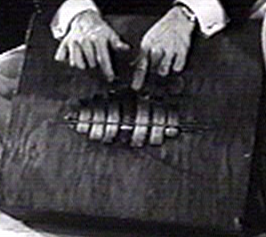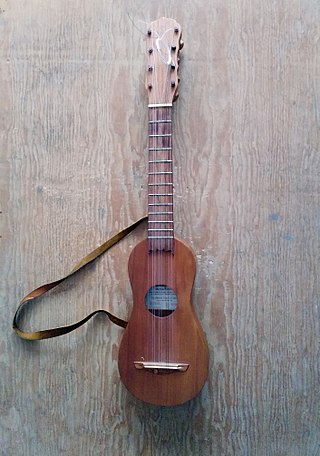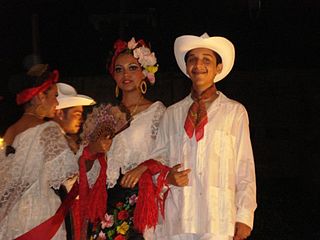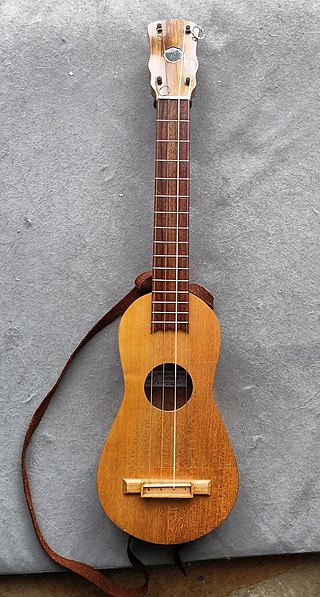The term conjunto refers to several types of small musical ensembles present in different Latin American musical traditions, mainly in Mexico and Cuba. While Mexican conjuntos play styles such as norteño and tejano, Cuban conjuntos specialize in the son, as well as its derivations such as salsa.

The music of Mexico is highly diverse, featuring a wide range of musical genres and performance styles. It has been influenced by a variety of cultures, primarily deriving from Europeans, Indigenous, and Africans. Music became an expression of Mexican nationalism starting in the nineteenth century. Mariachi, the musical organization that currently identifies Mexico, is an artistic expression that unifies the country and its inhabitants through its sounds. In November 2011, UNESCO inscribed Mariachi music, featuring strings, vocals, and trumpets, as part of the Representative List of the Intangible Cultural Heritage of Humanity.

The marímbula is a plucked box musical instrument of the Caribbean. In Cuba it is common in the changüí genre, as well as old styles of son. In Mexico, where it is known as marimbol is played in son jarocho; in the Dominican Republic, where it is known as marimba, it is played in merengue típico, and in Jamaica it is known as rumba box and played in mento.
The term requinto is used in both Spanish and Portuguese to mean a smaller, higher-pitched version of another instrument. Thus, there are requinto guitars, drums, and several wind instruments.
"La Bamba" is a Mexican folk song, originally from the state of Veracruz, also known as "La Bomba". The song is best known from a 1958 adaptation by Ritchie Valens, a Top 40 hit in the U.S. charts. Valens's version is ranked number 345 on Rolling Stone magazine′s list of the 500 Greatest Songs of All Time.

Huapango is a family of Mexican music styles. The word likely derives from the Nahuatl word cuauhpanco that literally means 'on top of the wood', alluding to a wooden platform on which dancers perform zapateado dance steps. It is interpreted in different forms, the most common being the classic huapango interpreted by a trio of musicians ; the huapango norteño interpreted by a group ; and the huapango de mariachi, which can be performed by a large group of musicians.

The Bajo sexto is a Mexican string instrument from the guitar family with 12 strings in six double courses.

The jarana jarocha is a guitar-shaped fretted stringed instrument from the southern region of the state of Veracruz, Mexico. Typically strung with 8 strings in 5 courses, usually arranged in two single outer strings with three double-courses in between. The strings are usually nylon, although they were gut in the past. The body is somewhat narrower than a guitar because of its direct lineage from the Spanish baroque guitar of the sixteenth century. Sometimes mistaken for a ukulele, the jarana jarocha comes in at least five sizes, the smallest being the chaquiste, somewhat smaller than a soprano ukulele; then the mosquito, about the size of a soprano ukulele; the 'primera', about the size of a concert ukulele; the 'segunda', in length between a tenor and a baritone ukulele; and the 'tercera', somewhat longer than the baritone ukulele. Some luthiers are building jaranas of a size they label "tercerola" or "jarana cuarta", but there is some discussion as to whether these represent a distinct size or are merely particularly large variations of the standard tercera.

Regional styles of Mexican music vary greatly from state to state. Norteño, banda, duranguense, Son mexicano and other Mexican country music genres are often known as regional Mexican music because each state produces different musical sounds and lyrics.

Son huasteco is one of eight Mexican song styles and is a traditional Mexican musical style originating in the six state area of Northeastern Mexico called La Huasteca. It dates back to the end of the 19th century and is influenced by Spanish and indigenous cultures. Usually it is played by a Trio Huasteco composed of a guitarra quinta huapanguera a Jarana huasteca and a violin. Singers will often use the falsetto register. The son huasteco is particularly noteworthy for its flamboyant and virtuoso violin parts, although the style varies from state to state. Footwork often danced to son huasteco is the Zapateado. Improvisation plays a strong role in the style, with musicians creating their own lyrics and arrangements to a standard repertoire. Typical sones huastecos are "Cielito Lindo", "La huazanga", "La sirena", "El querreque" and "La cigarra".

In Mexican Spanish, Jarocho is a colloquial demonym for residents of the State of Veracruz, Mexico, as well as an appellative term for anything related to said state.

Quetzal is a bilingual (Spanish-English) Chicano rock band from East Los Angeles, California.

The requinto jarocho or guitarra de son is plucked string instrument, played usually with a special pick. It is a four- or five-stringed instrument that has originated from Veracruz, Mexico. The requinto is used in conjunto jarocho ensembles. In the absence of the arpa, the requinto typically introduces the melodic theme of the son and then continues by providing a largely improvised counterpoint to the vocal line.
The arpa jarocha is a large wooden harp that is normally played while standing, although early examples from the 16th through the first three or four decades of the 19th centuries were smaller and were played while seated. It has a wooden frame, a resonator, a flat soundboard, 32-36 nylon strings, and does not have pedals. This harp is tuned diatonically over five octaves. The top of its soundboard sometimes arches outward due to the tension of the strings. Unlike other Mexican harps, the arpa jarocha has its sound holes located on the back of the soundboard instead of on the front.
Son de Madera is a son jarocho band based in Veracruz, Mexico. Its core members are Ramón Gutiérrez Hernández, Tereso Vega, and Rubí Oseguera Rueda. The band was founded in 1992 by Ramón Gutiérrez and Laura Rebolloso.
Son de Montón is a Mexican band founded in 2004 in Guanajuato, which fuses Mexican traditional music, especially son music and other musical styles with a purpose of bringing traditional music to younger audiences. The members are Ignacio Piñón Pérez, who plays violin, a guitar called a jarana and quijada, Anatolij Tkatschinski Pérez who plays jarana and quijada, Eduardo Vallejo Torres who plays percussion, Antonio López Cardons who plays jarana and harmonica, Fernanda Aldonza López Cardona, Primo Lara Stephens, Luis Jesús Cibrian García, José Abraham Morales Salazar and sound technician Jacob Sinuee Segoviano Alonzo. Its members come from Veracruz, Sinaloa, Chihuahua and Guanajuato, but the band is based in Guanajuato.
Los Soneritos is a group dedicated to Mexican folk music and dance, founded in 2005 in Colima by Omar Alejandro Rojas Ramos. Rojas Ramos formed the group while working at a primary school, giving classes in music and dance. It was formed with the express intention of preserving and promoting folk music and dance to youths and children. The group mostly performs music and dance from its home state of Veracruz such as son, fandango and zapateado, but other similar music such as son from the west of Mexico and the “mitote folkorico” is also in the repertoire. Members of the group have done research about traditional music and dance as well as composed their own original pieces.

Son mexicano is a style of Mexican folk music and dance that encompasses various regional genres, all of which are called son. The term son literally means "sound" in Spanish, and is also applied to other unrelated genres, most notably son cubano.
Las Cafeteras is a Chicano band from East Los Angeles, California. Their music fuses spoken word and folk music, with traditional Son jarocho and zapateado dancing.
Cambalache is a Son Jarocho band based in East Los Angeles, California. They are the one of key bands at the center of the son jarocho explosion in Los Angeles in 2010s.













